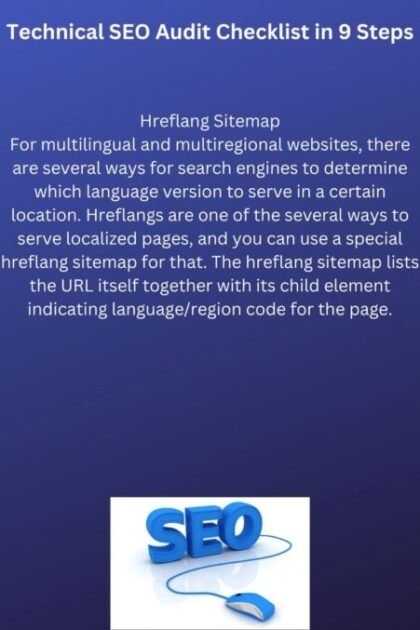The Technical SEO Audit Checklist consists of 9 steps that need to be followed in conducting a thorough audit. This checklist is a comprehensive guide to assess the technical aspects of a website and ensure its optimization.
By following these steps, you can identify and rectify any issues that might be affecting the website’s performance in search engine rankings. A systematic audit will check for factors such as site speed, mobile responsiveness, sitemap accuracy, broken links, URL structure, and more.
Conducting a Technical SEO Audit is essential to optimize a website’s visibility on search engines and enhance user experience.
Step 1: Crawl ability Analysis
Ensuring search engine bots can access and crawl your website is crucial for visibility in search engines. One way to achieve this is by analyzing the robots.txt file, which instructs search engine crawlers on which parts of your site to index and which to ignore. XML sitemaps also play a vital role in crawlability, as they provide a roadmap of all the available pages on your site.
By submitting an updated XML sitemap to search engines, you can ensure that all your important pages are indexed. Regularly checking for any crawl errors, such as broken links or pages with high load times, is essential for maintaining a healthy crawlability status. By prioritizing crawlability in your technical SEO audit, you lay a solid foundation for optimizing your website’s visibility in search engine results.
Step 2: Url Structure And Parameters
Having a clean and optimized URL structure is essential for both user experience and SEO. A well-structured URL can help users understand what the page is about before they even click on it, leading to higher click-through rates. Additionally, search engines also analyze URLs to determine the relevance and context of a page.
When optimizing URL structure, it’s important to keep them concise and descriptive. Removing unnecessary parameters in the URLs can also help prevent duplicate content issues and make it easier for search engines to crawl and index your site.
URL parameters can have a significant impact on indexing. It’s crucial to properly handle and manage them to avoid potential crawling and indexing issues. Some parameters can be ignored or set to not be indexed, while others may need to be kept or managed in a specific way to ensure search engine optimization.
Step 3: Website Speed And Performance
Website speed and performance are crucial factors that can significantly impact the user experience and search rankings. Ensuring that your website loads quickly is vital to retain the attention of visitors and reduce bounce rates. There are several **tools to measure and analyze website speed** to identify areas that need improvement. These tools can provide insight into factors like page loading time, server response time, and overall performance metrics.
Once you have identified areas for improvement, you can implement various **strategies for optimizing website performance**. These strategies include optimizing images and multimedia content, minifying CSS and JavaScript files, enabling browser caching, and leveraging content delivery networks (CDNs).
By prioritizing website speed and performance, you can offer a seamless browsing experience to your users and improve your chances of ranking higher in search engine results. With the right tools and optimization techniques, you can ensure that your website is always running at its best.
Step 4: Mobile Friendliness And Responsiveness
Mobile friendliness and responsiveness are critical factors in today’s digital landscape. With the majority of internet users accessing websites through mobile devices, it is essential to optimize your site for mobile. To ensure mobile optimization, follow best practices such as:
- Make sure your website is mobile-friendly, with a responsive design that adjusts to different screen sizes and devices.
- Test your website’s responsiveness across various devices and screen sizes to ensure a consistent and user-friendly experience.
- Optimize your site’s loading speed on mobile devices by compressing images and minimizing code.
- Consider implementing mobile-specific features like click-to-call buttons or mobile-friendly navigation menus.
- Utilize responsive images that adapt to different devices and screen resolutions.
- Create engaging and informative mobile content to meet the needs of on-the-go users.
By following these mobile optimization best practices, you can enhance user experience, improve mobile search rankings, and drive more traffic to your website.
Step 5: Indexing And Canonicalization
- Step 5: Indexing and Canonicalization
- Understanding how search engines index your website
- Search engines like Google need to effectively index your website to understand its content and rank it accordingly. To ensure efficient indexing, you can:
- Implement canonical tags: These tags help prevent duplicate content issues by specifying the preferred URL version for search engines. It ensures that multiple versions of the same content are not seen as separate pages.
- Verify indexation: Regularly check if your pages are indexed by search engines by using tools like Google Search Console or Bing Webmaster Tools. If you find any pages missing, you can troubleshoot and determine potential indexing errors.
- Resolve indexing errors: If you encounter indexing errors, such as blocked pages or URLs returning non-200 status codes, take necessary actions to fix them. Ensure that search engines can access and crawl your website without any issues.
Step 6: On-Page Seo Elements
| Optimizing Meta Tags, Titles, and Descriptions for Improved Visibility |
| One crucial aspect of on-page SEO is optimizing your meta tags, titles, and descriptions. Meta tags provide information about your webpage to search engines, enhancing its visibility. Ensure that your meta title accurately reflects the content of the page, and include relevant keywords to improve search engine ranking. Similarly, craft compelling meta descriptions that entice users to click through to your website. |
| Analyzing Header Tags and Content Structure |
| Another important aspect to consider in on-page SEO is properly utilizing header tags and structuring your content. Use header tags (H1, H2, etc.) to organize your content and make it more readable for both users and search engines. Ensure that your header tags contain relevant keywords to increase their SEO value. Additionally, maintain a logical content structure and break up large blocks of text with subheadings. This not only enhances user experience but also helps search engines understand the hierarchy and context of your content. |
| Incorporating Relevant Keywords Naturally within Your Content |
| One of the foundations of effective on-page SEO is the strategic use of keywords in your content. Avoid keyword stuffing (excessive and unnatural use of keywords), which can hurt your search engine rankings. Instead, incorporate relevant keywords naturally within your content. Optimize your headings, subheadings, and body text to provide valuable information to both users and search engines. Ensure keyword relevance in order to boost your visibility in search results. |
Step 7: Technical Markup Analysis
Step 7 of the Technical SEO Audit Checklist involves analyzing the technical markup of your website. This includes assessing the usage of structured data markup to enhance search result snippets. One important aspect is identifying and fixing HTML markup errors. These errors can negatively impact how search engines interpret and display your content.
By resolving these errors, you can ensure that your website is easily understood and indexed by search engines. Additionally, it is crucial to implement schema markup. Schema markup provides a way to categorize and structure your content, making it easier for search engines to understand and rank your website. By implementing schema markup, you can improve the visibility and relevance of your content in search engine results.
Step 8: Website Security And Https
Ensuring website security is vital for SEO. **Migrating to HTTPS** is an essential step in making your website secure. HTTPS encrypts the data that is transferred between the user’s browser and your website, protecting it from being intercepted by hackers.
Implementing **security measures** is equally important. Regularly **checking for vulnerabilities** and fixing them promptly can prevent potential security breaches. This involves employing secure coding practices, keeping software and plugins up to date, and using strong passwords.
Website security not only protects your visitors but also impacts your search engine rankings. Search engines prioritize secure websites and may display warnings for insecure ones, which can negatively impact user trust and site traffic.
Step 9: Off-Page Seo Factors
|
Step 9: Off-Page SEO Factors Analyzing incoming links and their quality When it comes to off-page SEO, analyzing your website’s incoming links and their quality is crucial for success. It’s essential to identify both the quantity and quality of backlinks to your site. First and foremost, you need to identify and remove toxic backlinks that may be harming your website’s ranking. These are low-quality or spammy links that can negatively impact your SEO efforts. Next, it’s important to focus on building high-quality backlinks to improve your website’s authority. This can be achieved through various strategies such as guest blogging, influencer outreach, and content promotion. By consistently monitoring your incoming links and ensuring their quality, you can effectively enhance your website’s off-page SEO and drive organic traffic to your site. |
Frequently Asked Questions For Technical Seo Audit Checklist In 9 Steps
What Is Technical Seo Audit Checklist?
A technical SEO audit checklist is a list of tasks and checks that are performed to evaluate and optimize the technical aspects of a website for search engines. It includes analyzing website performance, site structure, URL optimization, meta tags, sitemaps, robots.
txt, site speed, mobile-friendliness, and more to ensure the website is technically optimized for better search engine rankings.
How Do You Complete A Technical Seo Audit In 8 Steps?
To complete a technical SEO audit in 8 steps, follow these guidelines: 1. Start with keyword research and analysis. 2. Evaluate website structure and navigation. 3. Check URL structure and optimize for SEO. 4. Review meta tags, headings, and content for optimization.
5. Ensure proper indexing and sitemap implementation. 6. Analyze website speed and optimize for faster load times. 7. Check for mobile responsiveness and optimize as needed. 8. Conduct a thorough backlink analysis and remove any spammy links. By following these steps, you can effectively audit and enhance your website’s technical SEO performance.
How Do You Perform A Technical Seo Audit?
To perform a technical SEO audit, follow these steps: 1. Analyze website structure, URL structure, and internal linking. 2. Check for website speed and mobile-friendliness. 3. Review metadata, headings, and keyword usage. 4. Identify and fix broken links, crawl errors, and duplicate content.
5. Optimize XML sitemap and robots. txt file.
How To Perform A Technical Seo Audit In 15 Steps?
Performing a technical SEO audit involves these 15 steps: analyze site speed, check mobile-friendliness, review URL structure, optimize meta tags, examine site navigation, assess website security, evaluate internal linking, do a crawl analysis, check for duplicate content, analyze XML sitemaps, review robots.
txt file, examine 404 error pages, assess redirects, analyze image optimization, and check for structured data markup.
To sum up, conducting a technical SEO audit is crucial for optimizing your website’s performance and visibility in search engine results. By following this 9-step checklist, you can identify and resolve any underlying issues that may be hindering your site’s ranking.
From optimizing page speed and fixing broken links to ensuring proper indexing and analyzing user experience, a thorough audit will lay the foundation for a successful SEO strategy. So, take the time to evaluate and improve your website’s technical aspects, and watch as your organic traffic and rankings soar.

I have been working as an SEO Expert in Bangladesh for a long time and now providing the best SEO Service in Bangladesh. With the approach to Semantic SEO that eschews superfluity. I can get your business web page at the top of the SERP list. Using the latest digital marketing trends, I can enhance your online visibility and drive more website traffic.


